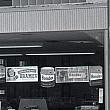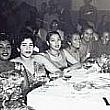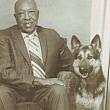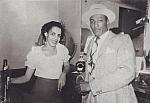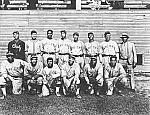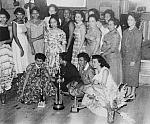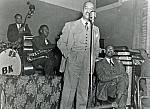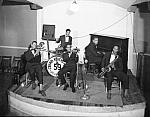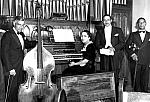
Roma Hall, Club Indigo, and Jazz
by Kim Rush, John Russo, and Martin Starr
Dances and floorshows held at Roma Hall commonly featured African-American entertainers. Herman Curtis was probably the first African-American musician to reside in and perform jazz music in Grand Rapids, as early as 1920. Curtis was a South Bend conservatory trained musician, playing both violin and upright bass. He was introduced in 1935 Roma Hall ads as “The Clown Prince of Jazz.” This was definitely a derivative title, yet accurately foreshadows his humorous personality and comical stage performances. The band names, which he used over the course of his career, such as Curtis Satonic 9-Piece Band of Grand Rapids, the Dusky Devastators of the Depression, Chocolate Vagabonds, NBC (Nobody But Curtis), and Herman Curtis and the Jazz Hounds also display his playfulness. During his lifetime he served as an auto mechanic, chauffeur, a boat captain, and had a truck body repair and painting business. For his truck-related business he utilized the last name of Curtisma in order that his advertising would appeal to the predominant Dutch community!
In the late 1930s, Mrs. Floyd H. Skinner composed a column that covered social events staged by Grand Rapids’ African-American community. Her column was posted regularly in the Chicago Defender newspaper. Her 9.26.36 article announced the opening of “The Club Indigo, Inc. …organized for the social, athletic, and civic advancement of our group. It is intended that a first class nightclub will be opened in the near future where its members and their guests may enjoy meals, beer, mixed drinks, and dancing in a refined atmosphere. Mr. Milo M. Brown, popular local undertaker, is president and manager of said Club, and announces that the club, located at 746 South Division Avenue, will be open for business in the very near future.” [1]
The entertainment provided at Club Indigo’s frequent dances resembled popular ”floor shows” of that time period, similar to Idlewild’s presentations or other venues located on the “chitlin circuit.” Grand Rapid’s Pierson Smith served shortly as their first M.C. Johnny Edwards, from Idlewild’s Paradise Club eventually served in this same capacity. They booked talent from Lansing, Saginaw, Battle Creek, Texas, Chicago, Kansas City, Detroit, St. Louis, and New York City, though not nationally renowned acts. At that time, Roma Hall was less than 2,000 square feet, and could not have accommodated a huge crowd. This venue was generally open three to four nights per week, and was operated by the Club Indigo, not the Russo family. Jenny Russo: “Club Indigo paid my father rent for the hall. They brought in entertainment, and had their own cook.”
An African American theatrical company from Chicago performed a musical comedy entitled “Shuffle Along” at Keith Theater located at 113-121 Lyon N.W. in Grand Rapids on 1.19.37. Later that evening, the entire cast was invited to Club Indigo and provided entertainment for the audience. One member of the cast was an eighteen-year-old pianist from Chicago named Nat (“King”) Cole. His band also played that night, though this was well before he enjoyed his highly successful recording career. [2]
As late as 4.1.39, Mrs. Skinner’s column spoke of Club Indigo being “beautifully redecorated and remodeled and open nightly under new management.” It appears to have operated at Roma Hall until at least February of 1940. Their listings in the Grand Rapids city directories disappear in 1940. According to a Crisis magazine article from April of 1939, Club Indigo sponsored a charity dance for the Grand Rapids Youth Council, although the specific location of this event was not mentioned.[3] Music for this event was furnished by the Club Indigo Orchestra and the Federal Music Project (WPA) band.
Gene Seals performed with the local WPA (Works Project Administration) band and served temporarily as leader of the Club Indigo house band. Arnold Allen and Bennie Carew also assumed the role of house bandleader, though it has not been documented that they were members of the WPA band. From 1935-1943 the WPA created both an African-American and white jazz band in Grand Rapids under the auspices of the FMP (Federal Music Project). Numerous quality jazz musicians were drawn to Grand Rapids to apply for these paying positions. One objective of the FMP was to eliminate segregation of workers based on race. The original intent of the program was to create only one band in various designated cities. Inter-racial bands generally worked well together, but it was found that establishments in some regions refused to hire black musicians. As a result, in markets such as Detroit and Grand Rapids, a separate African American band was created. A few of the members of the Grand Rapids WPA African-American band were Gene Seals, Burt Benton, Burt Brasier, Bernie Peacock, and Ham Allen.
[1] Chicago Defender 9.26.1936. Mrs. Floyd Skinner columns, located in the Chicago Defender newspaper from 1936 to 1939, are the most complete and informative documents concerning Club Indigo history that I have located so far.
[2] Chicago Defender 2.6.37.
[3] Crisis Magazine April 1939

 facebook
facebook